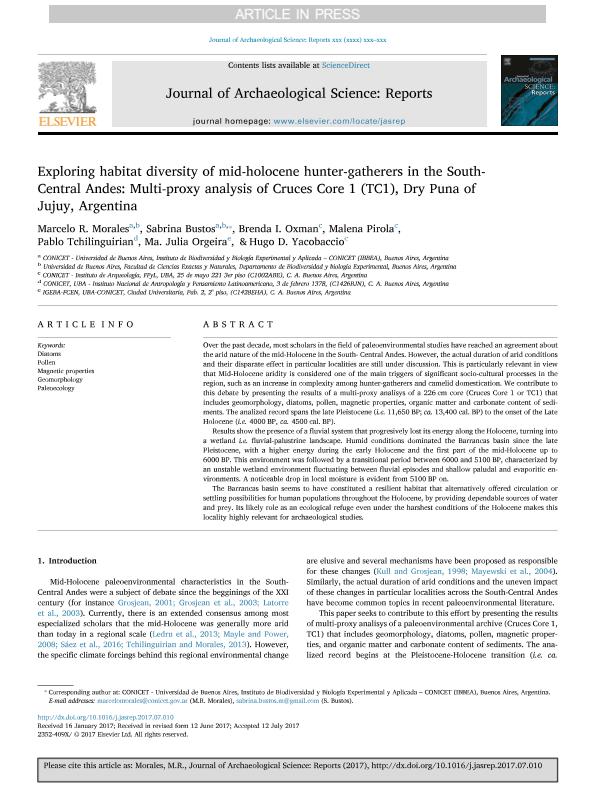Artículo
Exploring habitat diversity of mid-holocene hunter-gatherers in the South-Central Andes: Multi-proxy analysis of Cruces Core 1 (TC1), Dry Puna of Jujuy, Argentina
Morales, Marcelo Raul ; Bustos, Sabrina
; Bustos, Sabrina ; Oxman, Brenda
; Oxman, Brenda ; Pirola, Malena
; Pirola, Malena ; Tchilinguirian, Pablo
; Tchilinguirian, Pablo ; Orgeira, Maria Julia
; Orgeira, Maria Julia ; Yacobaccio, Hugo Daniel
; Yacobaccio, Hugo Daniel
 ; Bustos, Sabrina
; Bustos, Sabrina ; Oxman, Brenda
; Oxman, Brenda ; Pirola, Malena
; Pirola, Malena ; Tchilinguirian, Pablo
; Tchilinguirian, Pablo ; Orgeira, Maria Julia
; Orgeira, Maria Julia ; Yacobaccio, Hugo Daniel
; Yacobaccio, Hugo Daniel
Fecha de publicación:
10/2016
Editorial:
Elsevier
Revista:
Journal of Archaeological Science: Reports
ISSN:
2352-409X
Idioma:
Inglés
Tipo de recurso:
Artículo publicado
Clasificación temática:
Resumen
Over the past decade, most scholars in the field of paleoenvironmental studies have reached an agreement about the arid nature of the mid-Holocene in the South- Central Andes. However, the actual duration of arid conditions and their disparate effect in particular localities are still under discussion. This is particularly relevant in view that Mid-Holocene aridity is considered one of the main triggers of significant socio-cultural processes in the region, such as an increase in complexity among hunter-gatherers and camelid domestication. We contribute to this debate by presenting the results of a multi-proxy analisys of a 226 cm core (Cruces Core 1 or TC1) that includes geomorphology, diatoms, pollen, magnetic properties, organic matter and carbonate content of sediments.The analized record spans the late Pleistocene (i.e. 11,650 BP; ca. 13,400 cal. BP) to the onset of the Late Holocene (i.e. 4000 BP, ca. 4500 cal. BP).Results show the presence of a fluvial system that progresively lost its energy along the Holocene, turning into a wetland i.e. fluvial-palustrine landscape. Humid conditions dominated the Barrancas basin since the late Pleistocene, with a higher energy during the early Holocene and the first part of the mid-Holocene up to 6000 BP. This environment was followed by a transitional period between 6000 and 5100 BP, characterized by an unstable wetland environment fluctuating between fluvial episodes and shallow paludal and evaporitic environments. A noticeable drop in local moisture is evident from 5100 BP on. The Barrancas basin seems to have constituted a resilient habitat that alternatively offered circulation or settling possibilities for human populations throughout the Holocene, by providing dependable sources of water and prey. Its likely role as an ecological refuge even under the harshest conditions of the Holocene makes this locality highly relevant for archaeological studies.
Palabras clave:
Diatoms
,
Geomorphology
,
Magnetic Properties
,
Paleoecology
,
Pollen
Archivos asociados
Licencia
Identificadores
Colecciones
Articulos(IBBEA)
Articulos de INSTITUTO DE BIODIVERSIDAD Y BIOLOGIA EXPERIMENTAL Y APLICADA
Articulos de INSTITUTO DE BIODIVERSIDAD Y BIOLOGIA EXPERIMENTAL Y APLICADA
Articulos(SEDE CENTRAL)
Articulos de SEDE CENTRAL
Articulos de SEDE CENTRAL
Citación
Morales, Marcelo Raul; Bustos, Sabrina; Oxman, Brenda; Pirola, Malena; Tchilinguirian, Pablo; et al.; Exploring habitat diversity of mid-holocene hunter-gatherers in the South-Central Andes: Multi-proxy analysis of Cruces Core 1 (TC1), Dry Puna of Jujuy, Argentina; Elsevier; Journal of Archaeological Science: Reports; 10-2016; 1-14
Compartir
Altmétricas



